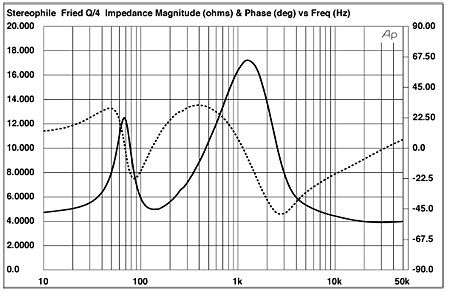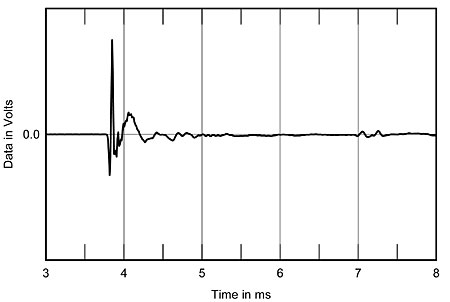| Columns Retired Columns & Blogs |
Fried Q/4 loudspeaker Measurements
Sidebar 2: Measurements
The Q/4 exhibited minor cabinet resonances at 100Hz and 120Hz, and a fairly strong mode at 260Hz that produced a buzzing from the enclosure. The Q/4's impedance magnitude and phase angle are shown in fig.1. The single impedance peak at 70Hz is more typical of a sealed-box tuning. Note also the slight dimple at the cabinet buzz frequency, 260Hz. (A much finer analysis would be required, however, for this cabinet problem to be fully revealed in this plot.) The impedance drops to 5 ohms through most of the bass, rises near the crossover frequency, then drops sharply to 4 ohms through the top octave. A 6 ohm or even 4 ohm rating would seem more appropriate than the specified 8 ohm impedance.

Fig.1 Fried Q/4, electrical impedance (solid) and phase (dashed). (2 ohms/vertical div.)
The Q/4's impulse response (fig.2) is quite clean, with very little ringing or overhang. The step response (fig.3) illustrates that while the woofer is connected in positive acoustic polarity, the tweeter, which leads the woofer in time, is inverted. This is done to compensate for the phase shift in the crossover region that arises from the use of a second-order crossover.

Fig.2 Fried Q/4, impulse response on tweeter axis at 45" (5ms time window, 30kHz bandwidth).

Fig.3 Fried Q/4, step response on tweeter axis at 45" (5ms time window, 30kHz bandwidth).
The Q/4's FFT-derived frequency response, spatially averaged over a 30° lateral window and measured on the HF axis, is shown in fig.4. The response is quite flat, with less rise in the treble than the other three loudspeakers reviewed in this issue. Although smooth through the midband and treble, there is a peak centered at about 3kHz, which might contribute to the slight nasal coloration noted. This, however, is greatly reduced 15° off-axis. At this angle, the treble also rolls off rapidly above 15kHz. The Q/4's nearfield woofer response, measured separately with the Audio Precision System One, has been appended to the spatially averaged frequency response. Curiously, the line-tunnel output in the nearfield (not shown) is virtually identical to the woofer's output shown. Typically, a port is tuned to augment bass output below the woofer's rolloff. It appears that the line tunnel does indeed reinforce the woofer's output rather than providing LF extension.

Fig.4 Fried Q/4, anechoic response on tweeter axis at 45", averaged across 30° lateral window and corrected for microphone response, with the nearfield woofer response plotted below 300Hz.
Finally, the Q/4's Cumulative Spectral Decay is shown in fig.5. The 3kHz peak is apparent and is accompanied by a minor ridge of delayed energy. Overall, the Q/4's waterfall plot is very clean through the treble. The dark line at 16kHz is the computer monitor's scanning frequency, not a loudspeaker characteristic. These measurements are, overall, good for an inexpensive loudspeaker.—Robert Harley

Fig.5 Fried Q/4, cumulative spectral-decay plot at 45" (0.15ms risetime).
- Log in or register to post comments




































